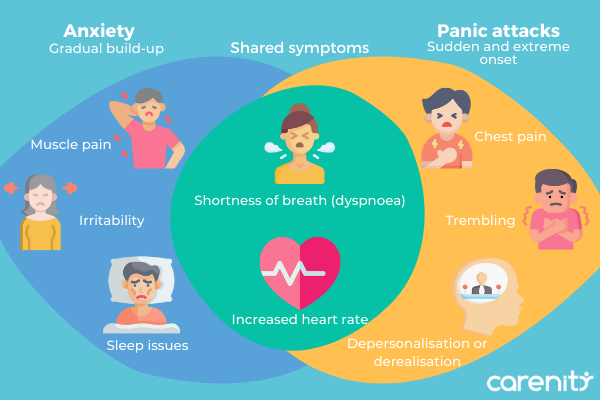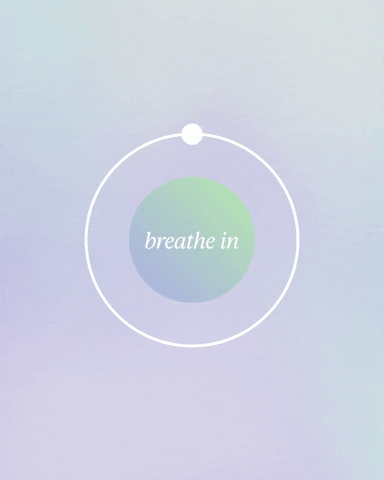Panic attacks: What are they and how to cope?
Published 22 Feb 2022 • By Courtney Johnson
Occasional anxiety is a normal part of life. However, when that anxiety impairs your ability to function in the day-to-day, it may be classified as an anxiety disorder. Anxiety disorders often involve repeated episodes of sudden feelings of intense anxiety, fear, or even terror that can last for minutes, called panic attacks.
What are panic attacks? Are they different from anxiety attacks? What causes them? How to prevent and treat them?
We answer these questions and more below!

What is a panic attack? Are they different than anxiety attacks?
Panic attacks are the primary symptoms of panic disorder, but can occur with other mental health conditions, such as anxiety disorders, which include generalised anxiety disorder (GAD), panic disorder, phobias, and separation anxiety. Panic attacks are characterised by an abrupt surge of a variety of emotional, physical, and cognitive symptoms that can feel uncontrollable and overwhelming.
The terms “anxiety attack” and “panic attack” are often used interchangeably. Though they do share some common symptoms, in practice anxiety and panic attacks have different features and signs.
The Diagnostic and Statistical Manual of Mental Disorders (DSM-5) does not reference anxiety attacks but does define anxiety as a feature of several common mental illnesses classed under the heading of anxiety disorders. Anxiety is usually linked to the anticipation of a stressful situation or event and tends to build up gradually. This lack of diagnostic recognition of anxiety attacks leads the signs and symptoms to be open to interpretation.
The DSM-5, however, does recognise panic attacks, categorising them as expected – meaning they are triggered by external stressors, such as phobias - or unexpected – meaning that they have an unknown or unobvious trigger. Panic attacks can occur as an isolated incident, but having regular, or multiple occurrences can be a sign of panic disorder.
Panic and anxiety attacks can feel similar and can even occur at the same time. For example, a person may experience anxiety about an upcoming test at school or presentation at work, and when the day arrives, this anxiety may peak with a panic attack.
According to the DSM-5, a panic attack is characterised by four or more of the following symptoms:
- Psychological symptoms
- Feeling detached from oneself (depersonalisation)
- Feeling detached from one’s surroundings (derealisation)
- Fear of losing control, going crazy, or dying
- Physical symptoms
- Chest pain
- Excessive sweating
- Feeling dizzy, lightheaded, or faint
- Chills
- Hot flashes
- Nausea or abdominal distress
- Heart palpitations, pounding or increased heart rate
- Feeling of choking
- Shaking or trembling
- Numbness or tingling sensation
- Shortness of breath or difficulty breathing
Panic attack symptoms generally peak within 10 minutes and subside, though some attacks may last longer or occur repeatedly.
Inversely, anxiety intensifies over time and has a strong correlation with excessive worry over a potential danger, whether real or perceived. If this worry builds up and the stress response escalates to a level where it becomes overwhelming, it may feel like an “attack”.
Anxiety symptoms typically include:
- Psychological symptoms
- Restlessness
- Irritability
- Difficulty concentrating
- Physical symptoms
- Increased heart rate
- Muscle tension and pain
- Dizziness
- Sleep issues
- Fatigue
- Raised startle response
While some of these anxiety symptoms are like those experienced during a panic attack, they are, as a rule, less intense. Though the symptoms of a panic attack are confined to a short period of time, anxiety symptoms can be persistent and long lasting – over days, weeks, or even months.

What causes panic attacks?
As mentioned above, panic attacks can be caused by a particular trigger, or can have no apparent cause.
A person is more likely to experience a panic attack if they:
- Have panic disorder
- Have another anxiety disorder or a condition involving psychosis
- Have certain medical conditions, such as thyroid, heart, or respiratory problems
- Take certain medications
- Use certain substances or have a substance use disorder
Panic attack triggers tend to vary from person to person and in some cases, there may be no obvious trigger. However, many patients find that the following situations can cause an attack:
- Conflict
- Situations that remind of a past or current stress in life
- Social events
- Public speaking
Can panic attacks be prevented? How to manage them?
As with many mental health conditions, some of the most common treatment options for panic attacks are counseling or psychotherapy, prescription medications, self-help strategies, or a combination of the three.
Some people find they can manage their attacks on their own by avoiding specific triggers, but this may not always be possible or appropriate, depending on the trigger and the situation.
While panic attacks cannot always be avoided, here are a few tips that can help you to get through them:
Close your eyes
While this may seem simple, oftentimes panic attacks come from triggers in the environment around you, filled with stimuli. During an attack, close your eyes to shut out any triggering stimuli that may make the attack worse. This can help you to focus your thoughts on your breathing.
Use deep breathing
Respiratory symptoms like shortness of breath or hyperventilation are common during panic attacks and can increase the feeling of fear. A study published in the journal Frontiers in Psychology in 2017 found that deep breathing (also called diaphragmatic breathing) helped improve patients’ emotional well-being and lower cortisol levels (and therefore stress).
By controlling your breathing, you can help control the hyperventilating that can make panic attacks worse.
During an attack, try to focus on your breathing with the 4-7-8 method: Take in a deep breath through your mouth, filling your chest and belly for a count of four, hold for seven seconds, and then breathe out through your mouth for a count of eight.
Imagine your breathing following this visual:
 GIF courtesy of Hers
GIF courtesy of Hers
Practice mindfulness
Another overwhelming symptom of a panic attack can be a feeling of separation from reality or your environment. Mindfulness techniques focus on focusing your attention on the present, acknowledging your current emotions, and meditating to reduce stress and ease yourself into a more relaxed state.
During an attack, focus your attention on physical sensations that are familiar to you – feeling the texture of your jeans or sweater or digging your feet into the ground. These familiar and specific sensations will help ground you and will give you something neutral to focus your attention on.
Repeat a mantra in your head
Having a mantra, a word or phrase repeated to help concentration during meditation, can be calming and reassuring during a panic attack, as it gives you something to listen to beyond your breathing.
Whether it’s something simple like “It’s ok”, “This too shall pass”, or something more personal to you, repeat your mantra in your head on a loop until you feel yourself calming and the panic attack subsiding.
If anxiety or panic attacks are affecting you in your daily life, make sure to speak with your doctor or another mental health professional. He or she should be able to help you find the best prevention and treatment options for you.
Having a treatment plan you can follow when faced with a panic attack can arm you with the tools to help you get through an attack and take an active role in managing your mental health!
Was this article helpful to you?
Give it a like and share your thoughts and questions with the community in the comments below!
Take care!
Sources:
Anxiety disorders, NIH National Institute of Mental Health
Anxiety and panic attacks, Mind UK
Ma, X., Yue, Z. Q., Gong, Z. Q., Zhang, H., Duan, N. Y., Shi, Y. T., Wei, G. X., & Li, Y. F. (2017). The Effect of Diaphragmatic Breathing on Attention, Negative Affect and Stress in Healthy Adults. Frontiers in psychology, 8, 874. https://doi.org/10.3389/fpsyg.2017.00874
What’s the Difference Between a Panic Attack and an Anxiety Attack, Healthline
How to Realistically Stop a Panic Attack, VeryWellHealth
Anxiety Attacks vs. Panic Attacks, VeryWellMind
12 Ways to Stop a Panic Attack, Healthline

 Facebook
Facebook Twitter
Twitter


